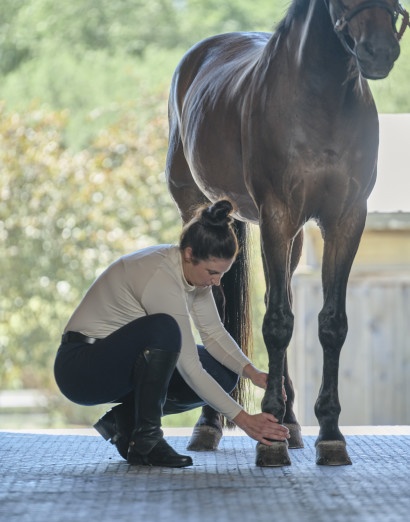Navicular Disease in Horses
- What is Navicular Disease in Horses?
- Supplements to Support Hoof Health and Circulation
- Diagnosing Navicular Disease
- Managing a Horse with Navicular
By: Dr. Lydia Gray | Updated May 20, 2025 by SmartPak Equine
What is Navicular Disease in Horses?

Navicular disease in horses generally refers to progressive degeneration of the navicular bone. This small bone in the hoof, also known as the distal sesamoid bone, is located behind the coffin bone or third phalanx.
Navicular syndrome is used to describe any condition causing pain in the area of a horse's navicular bone or the heel area, including the navicular bursa, deep digital flexor tendon, coffin joint, or any ligaments.
Video on Navicular Disease by Farrier Danvers Child
In this video, Danvers Child, CJF shows you the anatomy of the hoof and navicular bone, explains signs of navicular disease, and talks about how issues involving this area can affect soundness and overall health.
Supplements to Support Hoof Health and Circulation
Prescription joint products such as Legend® and Adequan® are often administered to horses with navicular, and it may also be helpful to provide an oral joint supplement with similar active ingredients (i.e. glucosamine, chondroitin sulfate and hyaluronic acid).
Because a normal response to inflammation is key to keeping a horse comfortable and managing stressed tissues, ingredients such as MSM, omega 3 fatty acids, and herbs such as boswellia, turmeric, and yucca may be beneficial.
Agents that support proper blood flow (like arginine, niacinamide, and gingko biloba) may also be of use.
Prescription Medications Available
If a specific structure within the hoof can be identified as diseased or injured, anti-inflammatories such as corticosteroids or Hyaluronic Acid (Legend®) may be injected directly into the area. Prescription non-steroidal anti-inflammatories (NSAIDS) such as bute (phenylbutazone) and Banamine® (flunixin meglumine) are commonly used to relieve pain.
The human drug isoxsuprine, a vasodilator which increases blood flow, is often prescribed because one theory suggests the disease is caused by lack of blood flow to the bone.
Diagnosing Navicular Disease
It is usually not difficult to localize lameness in the horse’s heel with an examination by a veterinarian that includes applying a hoof tester, flexing the lower limb, standing the horse on wedges, and blocking local nerves.
However, determining exactly what structure within the hoof is causing the pain can be a challenge. X-rays have always been the basis of a navicular diagnosis, but advanced diagnostic imaging methods such as x-rays with contrast dye, ultrasound, bone scan (nuclear scintigraphy) and especially magnetic resonance imaging (MRI) appear to be better at identifying which specific structures are involved.
Managing a Horse with Navicular
Corrective shoeing is a large component of the overall treatment plan for horses with navicular. Mild exercise to encourage vascularity and circulation is preferred over stall rest.
Extracorporeal shock wave therapy and desmotomy (cutting) of local ligaments are being explored as treatments. Cutting the nerves to the foot (palmar digital neurectomy) remains a last resort.
Video on Dealing with Navicular Issues
Dr. Gray answers a horse owner question on strategies for managing a horse with navicular syndrome, ingredients in supplements that may lend support, and specific diagnostics your veterinarian may use.
Questions to Ask Your Veterinarian
- Why did my horse develop navicular?
- How much longer will I be able to compete him?
- If he has the neurectomy, will he still be able to feel his foot and be safe to ride?